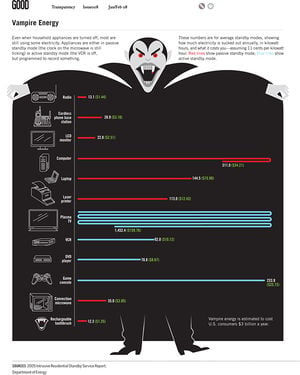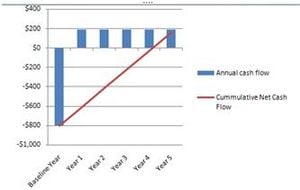
Phantom power is the power consumed by electrical appliances when they are switched off or not in use, but remain plugged in to an electrical socket. It is also known as standby power, the minimum amount of power required by an electrical device while plugged in. Although the phantom power consumption of one individual appliance may be trivial, many appliances within a home or business draw power when not in use, and this power consumption can accumulate. Another reference to phantom power is standby power or vampire power, this can be thought of as a leaky faucet and can account for a total of 10% of the energy costs for a residential home. The following articles provide a comprehensive background on phantom power, its effects, and how it can be mitigated.
Example[edit | edit source]
A medium-sized business has twenty cubicles, each equipped with an LCD monitor, computer, phone, and printer. These devices use a combined standby power draw of 20.56 watts for an average of 2.63 kWh per week (assuming 8 hour workdays from Monday to Friday). At an average power cost of 7 cents per kWh, this results in a cost of $9.61 per year per cubicle. Replacing all of the current power bars with energy-saving bars (with a cost of approximately $40 each) would result in a payback time of 4.16 years.
| Cash Flows | Baseline Year | Year 1 | Year 2 | Year 3 | Year 4 | year 5 |
|---|---|---|---|---|---|---|
| Annual cash flow | ||||||
| $192 | $192 | $192 | $192 | $192 | ||
| Cummulative Net Cash Flow | ||||||
| $161 |

If you are interested in saving money, energy, or carbon through the use of phantom power reducing power bars, please download the following Excel spreadsheets to help with your economic and environmental analysis.
Analysis file: Replacement of conventional power bars with "smart" bars
Literature Review[edit | edit source]
This section provides an annotated bibliography of relevant literature that was used to create and support this analysis.
Overview Articles[edit | edit source]
Saving Energy by Avoiding Phantom Power[2][edit | edit source]
A brief introduction to phantom power, this article stems from an eco-lifestyle television network called Planet Green. Born in 2008, Planet Green is present both on television and online, and exists to provide information to a broad range of individuals regarding ways to improve the environmental status of our planet. The article covers an introduction to what phantom power is, and why it is necessary to attempt to reduce its consumption.
Standby Power – Addressed in Australia[3][edit | edit source]
Australia is one of the world leaders in addressing phantom power issues, and therefore this source was found to determine what some potential solution paths are. Australia addressed phantom power issues for the first time in 2002, and since then they have been working with industries to help reduce the phantom power consumption of appliances. However, since many of the appliances used in Australia are produced overseas (and therefore are not manufactured to keep phantom power consumption to a minimum), the Office of Energy in the Australian government addresses the fact that if an individual does not want to unplug each of their appliances, there are power bars available that can help reduce phantom power consumption.
How to Buy Products with Low Standby Power[4][edit | edit source]
The United States Department of Energy has recognized phantom power consumption to be a significant issue, and has therefore created a policy stating that on a federal level, appliances purchased must comply with certain phantom power regulations. This source shows that on a large scale especially, phantom power consumption is a problem that needs to be addressed.
How to Reduce Phantom Power[5][edit | edit source]
This source further shows the importance of reducing phantom power consumption. Although it is not a government regulated site or a scholarly article, it is a forum for environmentally-minded individuals to post their advice for being more sustainable. This article focuses on phantom power consumption and the importance of its reduction, and is accompanied by a list of methods by which to reduce phantom power consumption in households.
Phantom Power Data[edit | edit source]
Phantom Power Consumption of Common Household Appliances[6][edit | edit source]
In a study done by the Lawrence Berkeley National Laboratory, many household and business appliances were measured to determine their phantom power consumption. A total of 58 different types of appliances were tested, and for each type of appliance, anywhere from 1 to 64 actual products were measured. The data gathered involves the average phantom power consumption, along with the maximum and minimum. This was an unbiased study carried out to demonstrate how much could be saved by eliminating the phantom power consumption of different appliances in your home or business. Although not completely precise due to the averaging of values, and the lack of specification between models of appliances, the study provides a rough estimation of how much phantom power is consumed by each appliance. The study also draws the conclusion that nearly 10% of home electricity use is a direct result of phantom power.
International Standby Data Project[7][edit | edit source]
The purpose of the International Standby Power Data Project is to collect data on standby power from seven different countries in order to facilitate international comparisons and draw trends in standby consumption. By setting standards for the collection of this data, these countries were able to collaborate in order to determine in-depth issues regarding phantom power consumption. The project was initiated as part of the Asia Pacific Partnership on Clean Development and Climate Change, and includes Australia, Canada, China, India, Japan, Republic of Korea, and the United States of America. The information is represented graphically in the above link, demonstrating the distribution of devices within a certain category of appliances.
Standby Power[8][edit | edit source]
Information on what standby power is and how to define and cut back on standby power (phantom power) in a consumer household. A list of current residential electricity consumption data and facts and relevant reports and links are provided. This website also provides additional sources on information about standby power. Various programs are listed along with consumer methods to help reduce standby power.
Monitoring Device Options (Passive)[edit | edit source]
Watts Up?[9][edit | edit source]
Various configurations are available to be integrated into building infrastructure. Connect via Ethernet for minute-by-minute data collection and scheduling/control of entire circuits. This is a high-cost option with devices starting at approximately $200 per circuit.
Consumption-Reducing Device Options (Active)[edit | edit source]
Standby Plug[10][edit | edit source]
A low-cost device (approximately $20) that shuts off automatically after two minutes of inactivity is detected. Can be used on virtually any appliance or device, and occupies only one plug in each outlet. One Standby Plug is required for each device.
Beaming Sun[11][edit | edit source]
Multiple options with versatile configuration, these power bars use consume less than 1 W when fully energized. Average of three-month payback period cited.[11] Also includes surge protection.
Bits Ltd Smart Strip Power Strip[12][edit | edit source]
With 10 outlets and surge protection, this is a versatile device. Relatively low cost (approx. $40).
WattStopper Isolé[13][edit | edit source]
Using passive infrared technology, the power bar switches all devices on/off. Coverage is approximately 300 sq.ft. at 120-degree viewing angle, but can be expanded with multiple sensors and expansion pack. Relatively high-cost option (approx. $90), but more desirable for locations where occupants are ambivalent to electricity consumption, because they are not responsible for its cost.
Mini Power Minder[14][edit | edit source]
Connecting via USB to a computer, peripheral devices (printer, scanner, speakers, monitors, etc.) can be shut off when the computer is shut down. A very affordable option (approx. $15) to simplify leaving a workspace.
Peer-Reviewed and Published Literature[edit | edit source]
Energy Consumption by Office and Telecommunications Equipment in Commercial Buildings: Volume I – Energy Consumption Baseline[15][edit | edit source]
A detailed examination of electronic equipment typically found in office buildings, as commissioned by the Office of Building Equipment, Office of Building Technology State and Community Programs. Outlined is the need for equipment with lower stand-by consumption and methods by which this can be obtained for several devices.
Sources for Economic and Environmental Analysis[edit | edit source]
Ontario's Minimum Wage Increases[16][edit | edit source]
Used in determining cost of labour to transition business from existing power bars to new technology.
References[edit | edit source]
- ↑ US Department of Energy. "Intrusive Residential Standby Service Report". 2005.
- ↑ Dunn, Colin. "Saving Energy by Avoiding Phantom Power". Planet Green. March 23, 2008.
- ↑ Government of Western Australia. "Standby Power". Office of Energy. February 2, 2009.
- ↑ US Department of Energy. "How to Buy Products with Low Standby Power". Federal Energy Management Program. July 14, 2009.
- ↑ Ecohuddle. "How to Reduce Vampire Power". 2010.
- ↑ Meier, Alan. "Standby Power Summary Table". Lawrence Berkeley National Laboratory. 2009.
- ↑ Asia Pacific Partnership on Clean Development and Climate Change. "International Standby Power Data Project". Asia Pacific Partnership. 2009.
- ↑ Lawrence Berkely National Laboratroy: Standby Power [1] (Accessed: 3/28/2015).
- ↑ http://web.archive.org/web/20170930142040/https://www.wattsupmeters.com/secure/index.php
- ↑ http://web.archive.org/web/20170522033312/http://nomorestandby.com/
- ↑ 11.0 11.1 http://web.archive.org/web/20101006043857/http://www.beamingsun.com:80/market/energy/smart_strip.php
- ↑ http://web.archive.org/web/20110602155123/http://catalog.bitsltd.us:80/
- ↑ http://www.wattstopper.com/products/details.html?id=74
- ↑ http://gizmodo.com/215879/mini-power-minder-a-plug-that-cares
- ↑ Energy Consumption by Office and Telecommunications Equipment in Commercial Buildings: Volume I – Energy Consumption Baseline. K.W. Roth, F. Goldstein, J. Kleinman. Arthur D. Little, Inc. Cambridge, MA. (2002).
- ↑ Ontario Ministry of Labour: Ontario's Minimum Wage Increases http://web.archive.org/web/20140108012445/http://www.labour.gov.on.ca:80/info/minimumwage/ (Accessed: 7/2/2010).